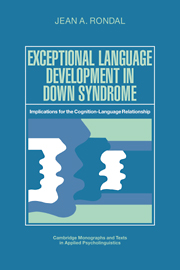 Exceptional Language Development in Down Syndrome
Exceptional Language Development in Down Syndrome Book contents
- Frontmatter
- Contents
- Foreword by Neil O'Connor
- Acknowledgments
- 1 Introduction
- 2 Language development in Down syndrome
- 3 Exceptional language development in mentally handicapped individuals
- 4 Cognition-language relationships and modularity issues
- 5 A case study
- 6 Theoretical discussion
- 7 General conclusions
- Appendixes
- References
- Index
3 - Exceptional language development in mentally handicapped individuals
Published online by Cambridge University Press: 23 December 2009
- Frontmatter
- Contents
- Foreword by Neil O'Connor
- Acknowledgments
- 1 Introduction
- 2 Language development in Down syndrome
- 3 Exceptional language development in mentally handicapped individuals
- 4 Cognition-language relationships and modularity issues
- 5 A case study
- 6 Theoretical discussion
- 7 General conclusions
- Appendixes
- References
- Index
Summary
The preceding review of studies on language development in DS may have left the impression of a relative uniformity in the patterns of development. Indeed, research on language development in DS children has most often been conducted from an implicit theoretical stance assuming basic uniformity. Few data bear on the question of variation in language acquisition and functioning in DS subjects (see J. Miller, 1988, for a significant exception). In so doing, this subfield of psycholinguistics, as it applies to DS, mirrors the general tendencies that can be observed in developmental psycholinguistics at large. Much research on language in the NR children has been concerned with the supposedly invariable course of development, not only for particular languages, but also at a more abstract level and between languages (e.g., Slobin, 1985). A so-far limited number of studies have shown, however, that there is considerable inter – and intraindividual variation in rate or quantitative aspects of language acquisition as well as noticeable differences in patterns and/or styles of acquisition (see Peters, 1983; Goldfield & Snow, 1985; Bates, Bretherton, & Snyder, 1988; Bates & MacWhinney, 1987, for reviews and discussions). Observing and explaining variations in patterns of development is important because it may indicate the extent to which language acquisition may be constrained by a number of factors, such as the characteristics of the target language, the physical and the verbal environment in which development takes place, and of course, the child.
- Type
- Chapter
- Information
- Exceptional Language Development in Down SyndromeImplications for the Cognition-Language Relationship, pp. 19 - 50Publisher: Cambridge University PressPrint publication year: 1995


